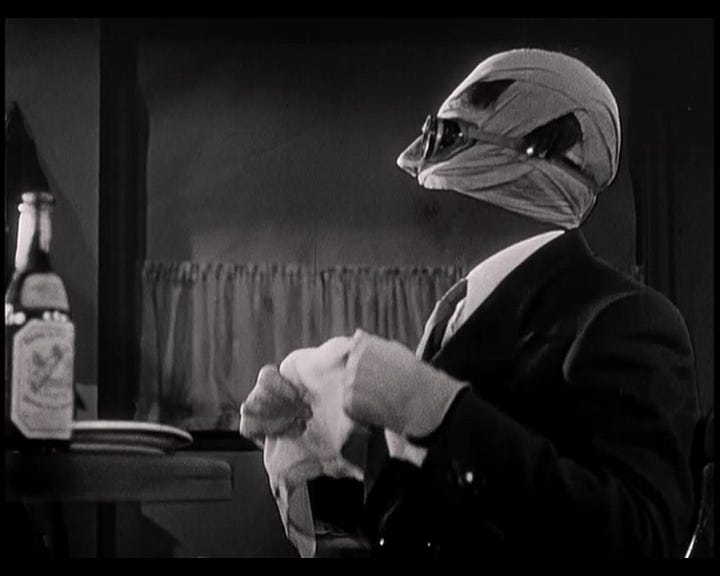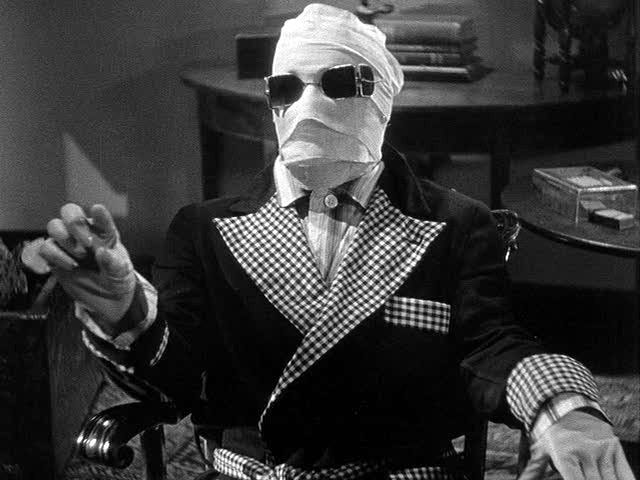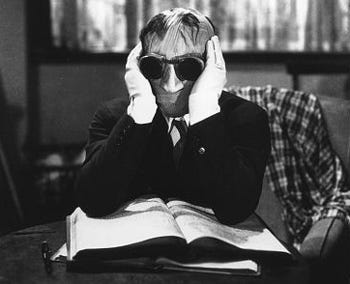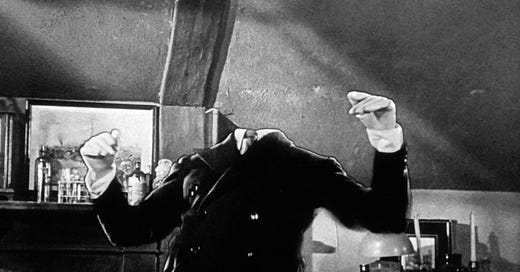THE INVISIBLE MAN
1933 • James WhaleScreenplay: R. C. Sherriff; Based on The Invisible Man 1897 novel by H. G. Wells
Cast: Gloria Stuart, Claude Rains, William Harrigan, Dudley Digges, Una O'Connor, Henry Travers, Forrester Harvey
Cinematography: Arthur Edeson
Music: Heinz Roemheld
Producer: Carl Laemmle Jr.
Universal Pictures
An invisible man can rule the world. Nobody will see him come, nobody will see him go. He can hear every secret. He can rob, and rape, and kill!
Dr. Jack Griffin (Claude Rains) makes a groundbreaking discovery by accidentally concocting a chemical that renders the user invisible. Griffin becomes obsessed with his newfound power. Wrapping himself in bandages to conceal his invisibility, he isolates himself in an inn. Soon, he realizes the potential of his ability and starts using it for diabolical pursuits. However, as he reveals his invisible state to his fiancee and mentor, it becomes apparent that the potion has driven him to murderous insanity. The police engage in an aggressive manhunt, but capturing an invisible man proves to be an almost impossible challenge.
Among the myriad Universal Monster movies of the 1930s, 40s, and 50s, The Invisible Man stands out as my personal favorite. This iconic film directed by James Whale is a thrilling concoction of science fiction, horror, and humor, leaving an indelible mark on the cinematic landscape.
At the heart of the story is Dr. Jack Griffin, portrayed brilliantly by Claude Rains, whose accidental discovery of invisibility leads him down a dark and sinister path. Rains' performance, despite not physically appearing until the end of the film, is nothing short of remarkable. His portrayal of Griffin's descent into madness is chilling and unforgettable.
What truly sets this film apart, however, is its revolutionary use of special effects. In an age long before CGI, the filmmakers employed practical effects to make Claude Rains disappear on screen. Watching Griffin remove his bandages and vanish into thin air is still a marvel to behold, showcasing the ingenuity and creativity of the filmmakers. The movie employed a combination of practical effects, clever camera tricks, and innovative set designs to achieve the illusion of invisibility. Claude Rains wore a specially designed black velvet suit, which absorbed light and made him appear invisible against certain backgrounds. The special effects team also used matte painting and miniatures to create scenes where objects seemed to move on their own. Invisible wires were used to manipulate objects, creating the eerie impression of an unseen presence. Precise choreography and careful planning were essential to ensure that the movements of Jack Griffin synchronized seamlessly with the visible actors and surroundings. These pioneering methods, although rudimentary by today's standards, laid the foundation for future special effects in cinema and contributed to the enduring appeal of The Invisible Man. The VFX remain highly enjoyable even in the modern era, serving as a testament to the film's enduring appeal.
While The Invisible Man’s success lies in its technical achievements, it's also worth noting the insightful direction of James Whale and the solid, tight scripting that keeps the audience engaged from start to finish. It boasts a cleverly crafted plot, filled with witty dialogue and excellent character acting. The film strikes a perfect balance between thrills, drama, and some humor, making it a timeless classic. However, every masterpiece has its flaws, and in this case, Una O'Connor's over-the-top performance stands out amidst the otherwise stellar cast.
The Invisible Man marked Claude Rains' first major film role, and despite his limited screen time (or lack thereof, considering he’s, you know, invisible), he left an indelible impression. His performance is nothing short of extraordinary, showcasing his exceptional talent as an actor. Despite the challenge of conveying emotions and depth without the use of facial expressions or visible body language, Rains masterfully brings Dr. Jack Griffin to life. Through his voice, he captures the essence of a brilliant scientist descending into madness, his tone shifting from charismatic confidence to maniacal fervor. Rains' ability to infuse Griffin with a complex blend of intelligence, arrogance, and eventual desperation makes the character hauntingly real. His voice becomes the focal point, conveying Griffin's unraveling sanity and the dark consequences of his scientific experimentation. Rains' nuanced and captivating performance is a testament to his skill, turning what could have been a one-dimensional role into a layered and memorable one.
The Invisible Man remains a cinematic marvel, a testament to the creativity and innovation of early filmmakers. Its legacy lives on and it spawned a series of Universal sequels, each progressively diminishing in quality. Following the original 1933 film, the sequels included The Invisible Man Returns (1940), The Invisible Woman (1940), Invisible Agent (1942), The Invisible Man's Revenge (1944) and of course the comedic farce of Abbott and Costello Meet the Invisible Man (1951). Despite their attempts to capture the magic of the original, these sequels failed to replicate the brilliance of the first installment. Over the years, there have been various adaptations and reinterpretations of H.G. Wells' classic novel. However, none managed to truly recapture the essence of the original until 2020's remake. Directed by Leigh Whannell and starring Elisabeth Moss, the 2020 adaptation breathed new life into the story. Moss delivered a powerhouse performance as a woman tormented by her abusive, invisible ex-husband. The film skillfully blended elements of horror, suspense, and psychological thriller, offering a modern and gripping take on the invisible terror. The remake proved that the tale of an invisible stalker can still captivate audiences in the 21st century.
We'll begin with a reign of terror, a few murders here and there, murders of great men, murders of little men - well, just to show we make no distinction.
Streaming: Prime, IndieFlix
Digital Rental/Purchase: Available at most digital retailers
Physical Media: Available on 4K, Blu-Ray and DVD








